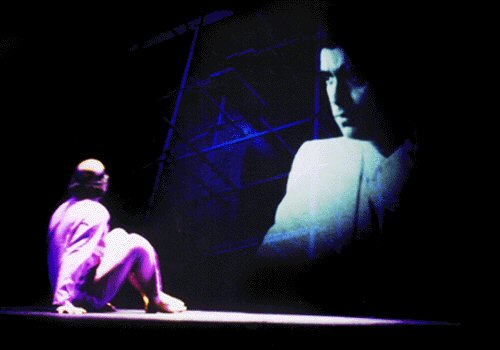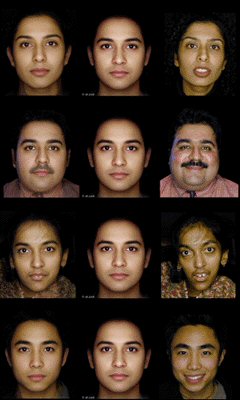Please wait a few moments while we process your request

motiroti
(London, England, United Kingdom)
Founded in 1991 by Keith Khan and Ali Zaidi, motiroti brings together artists who are devoted to multidisciplinary exploration and whose work has been presented internationally. The collective investigates how forms of expression circulate among cultures and seeks to foster exchanges among communities in Britain. The collective's mandate is to reach a diverse audience made up of followers of avant-garde theatre and the general public. motiroti's approach draws on several art forms. Previous credits include theatre productions and performances, installations, urban interventions and short films.
Commissioned by the London International Film Festival (London, England, United Kingdom) in 1993, Moti Roti Puttli Chunni (1993) was the first part in a series of theatre productions of epic proportion that combine film excerpts with live action on stage. The larger-than-life figures of Bombay's commercial film industry punctuate the everyday lives of three generations of Indians living in London. (1) These segments serve as interludes in the piece's narrative framework and are often emulated in an ironic way by the players. Hailed by critics for its formal and thematic audacity, Moti Roti Puttli Chunni garnered the Time Out London Dance and Performance Award. The pieces One Night (1997) and Maa (1995) use similar strategies to explore the cultural divide between first and second generation Indian immigrants.
Keith Khan and Ali Zaidi have also acted as set designers and directors for large-scale events such as Flying Costumes, Floating Tombs (1991) created for the London International Festival of Theatre in 1991. Other, more modest projects have cultivated an intimate rapport with spectators. In Wigs of Wonderment (1995-2001), motiroti orchestrates encounters between members of the public and participants from London's black community. To debunk the spectators' latent prejudices, the performance is accompanied by masquerade and dress-up games. Since 1995, the event has been restaged at several festivals in Europe, including Beweeging 5 in Antwerp, Belgium, in 1999. motiroti makes use of the urban setting for interventions that are both playful and political. In The Seed, The Root (1995), guided tours organized by the collective allowed spectators to explore Spitalfields Market and Brick Lane in London's East End.
Though best known for their performances, the members of motiroti have also produced numerous installations in galleries and museums. The 1993 installation Captives, presented at the New and Old Walsall Museum and Art Gallery, dealt with the theme of cultural appropriation by linking exotic fish behind glass with Asian objects prized in the West (silk, calligraphy). Fresh Asian (2000), shown at the Warwick Arts Centre (Warwick, England, United Kingdom), relied on public participation to deconstruct the stereotype that all Asians look alike. After declaring themselves to be of Asian origin, visitors could photograph themselves and add their face to a bank of pictures. The installation was made up of triptychs displaying a self-portrait alongside a composite face (the morphed features of 72 male and female participants). Finally, a third image superimposed the participant's features on this neutral face.
Other projects have sought testimonials from visitors. In Build (2000), presented at the Tate Modern (London, England, United Kingdom) in May 2000, motiroti collected life stories and photographic self-portraits from British adolescents of different cultures in order to mark the arrival of the new millennium. Reality Bytes (2000), a CD-ROM compilation, provided a forum for young Asian women of Nottingham. The compilation is composed of four segments, each by one participant. Through short documentary films and interactive stories, the participants explore the heritage passed down by their parents, describe their everyday experiences in a British context and take a critical look at the stereotypes in popular Indian films and in the mass media.
motiroti's works and performances are sometimes derived from larger projects concerning issues that require a multidisciplinary approach. This is the case with Alladeen , developed with the collective The Builders Association (New York, United States). The various components of this formidable project will emphasize the subversive yet accessible elements of Moti Roti's work to deconstruct stereotypes.
Commissioned by the London International Film Festival (London, England, United Kingdom) in 1993, Moti Roti Puttli Chunni (1993) was the first part in a series of theatre productions of epic proportion that combine film excerpts with live action on stage. The larger-than-life figures of Bombay's commercial film industry punctuate the everyday lives of three generations of Indians living in London. (1) These segments serve as interludes in the piece's narrative framework and are often emulated in an ironic way by the players. Hailed by critics for its formal and thematic audacity, Moti Roti Puttli Chunni garnered the Time Out London Dance and Performance Award. The pieces One Night (1997) and Maa (1995) use similar strategies to explore the cultural divide between first and second generation Indian immigrants.
Keith Khan and Ali Zaidi have also acted as set designers and directors for large-scale events such as Flying Costumes, Floating Tombs (1991) created for the London International Festival of Theatre in 1991. Other, more modest projects have cultivated an intimate rapport with spectators. In Wigs of Wonderment (1995-2001), motiroti orchestrates encounters between members of the public and participants from London's black community. To debunk the spectators' latent prejudices, the performance is accompanied by masquerade and dress-up games. Since 1995, the event has been restaged at several festivals in Europe, including Beweeging 5 in Antwerp, Belgium, in 1999. motiroti makes use of the urban setting for interventions that are both playful and political. In The Seed, The Root (1995), guided tours organized by the collective allowed spectators to explore Spitalfields Market and Brick Lane in London's East End.
Though best known for their performances, the members of motiroti have also produced numerous installations in galleries and museums. The 1993 installation Captives, presented at the New and Old Walsall Museum and Art Gallery, dealt with the theme of cultural appropriation by linking exotic fish behind glass with Asian objects prized in the West (silk, calligraphy). Fresh Asian (2000), shown at the Warwick Arts Centre (Warwick, England, United Kingdom), relied on public participation to deconstruct the stereotype that all Asians look alike. After declaring themselves to be of Asian origin, visitors could photograph themselves and add their face to a bank of pictures. The installation was made up of triptychs displaying a self-portrait alongside a composite face (the morphed features of 72 male and female participants). Finally, a third image superimposed the participant's features on this neutral face.
Other projects have sought testimonials from visitors. In Build (2000), presented at the Tate Modern (London, England, United Kingdom) in May 2000, motiroti collected life stories and photographic self-portraits from British adolescents of different cultures in order to mark the arrival of the new millennium. Reality Bytes (2000), a CD-ROM compilation, provided a forum for young Asian women of Nottingham. The compilation is composed of four segments, each by one participant. Through short documentary films and interactive stories, the participants explore the heritage passed down by their parents, describe their everyday experiences in a British context and take a critical look at the stereotypes in popular Indian films and in the mass media.
motiroti's works and performances are sometimes derived from larger projects concerning issues that require a multidisciplinary approach. This is the case with Alladeen , developed with the collective The Builders Association (New York, United States). The various components of this formidable project will emphasize the subversive yet accessible elements of Moti Roti's work to deconstruct stereotypes.
Vincent Bonin © 2001 FDL










